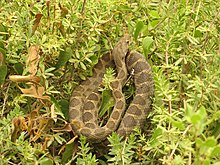| Coin-marked snake | |
|---|---|

| |
| Conservation status | |
 Least Concern (IUCN 3.1) | |
| Scientific classification | |
| Domain: | Eukaryota |
| Kingdom: | Animalia |
| Phylum: | Chordata |
| Class: | Reptilia |
| Order: | Squamata |
| Suborder: | Serpentes |
| Family: | Colubridae |
| Genus: | Hemorrhois |
| Species: | H. nummifer |
| Binomial name | |
| Hemorrhois nummifer (Reuss, 1834) | |
| Synonyms | |
| |
Hemorrhois nummifer, also known as the coin-marked snake, Asian racer, and leaden-colored racer, is a species of snake belonging to the family Colubridae. It is found in southeastern Europe, Western and Central Asia, and northeast Africa.
Geographic range
Hemorrhois nummifer is found widely in Western and Central Asia (Turkey southward to Syria, Lebanon, northern and central Israel, western and northwestern Jordan, and eastward to Armenia, northern Iraq, northeastern Iran, Turkmenistan, southern Uzbekistan, Tajikistan, and Kyrgyzstan) and also occurs in extreme southeastern Europe (Greece: the Aegean islands, including Kalymnos, Kos, and Lipsi; Cyprus). Isolated populations exist in northern Egypt (near Cairo and in the southern Sinai Peninsula).
Description
Hemorrhois nummifer can grow to 100 cm (39 in) in total length but is often smaller. The body is strong and fairly robustly built. It is brown, grey, or olive grey above and often has a dorsal row of about 57–65 large spots, turning into a continuous line on the tail. Smaller spots complement the larger spots on the sides. The belly is grey white.
Habitat
Hemorrhois nummifer occurs in open areas, including open dry woodland and shrubland, with some rocks and bushy vegetation. It is an adaptable species that inhabits both rural and urban areas. It is typically a lowland species but can be found at elevations up to 2,000 m (6,600 ft) in Turkey.
Behaviour and ecology
This snake is a diurnal, actively foraging predator with a diet consisting mainly of small mammals, lizards, and small birds. It is harmless to humans but appears to mimic vipers both in appearance and behaviourally (i.e., Batesian mimicry).
References
- ^ Aghasyan, A.; Avci, A.; Tuniyev, B.; Lymberakis, P.; Andrén, C.; Cogalniceanu, D.; Wilkinson, J.; Ananjeva, N.B.; Üzüm, N.; Orlov, N.L.; Podloucky, R.; Tuniyev, S.; Kaya, U.; Tok, V.; Ugurtas, I.H.; Sevinç, M.; Hraoui-Bloquet, S.; Sadek, R.; Crochet, P.-A.; Disi, A.M.; Werner, Y.L.; Baha El Din, S.; Borkin, L.; Milto, K.; Golynsky, E.; Belouskova, A.; Nuridjanov, D.; Munkhbayar, K.; Shestapol, A.; Dujsebayeva, T. (2017). "Hemorrhois nummifer". IUCN Red List of Threatened Species. 2017: e.T157270A746934. doi:10.2305/IUCN.UK.2017-2.RLTS.T157270A746934.en. Retrieved 2 November 2021.
- Reuss, Adolph (1834). Zoologische miscellen. Reptilien, Ophidier. Abhandlungen aus dem Gebiete der beschreibenden Naturgeschichte (in German). Vol. 1. pp. 129–162.
- ^ Hemorrhois nummifer at the Reptarium.cz Reptile Database. Accessed 2 November 2021.
- Academy, Reptile (2024-06-09). "A Comprehensive Review of Hemorrhois nummifer". לוכד נחשים - מוקד מחוז ירושלים (in Hebrew). Retrieved 2024-06-09.
- ^ Arnold, E. Nicholas & Ovenden, Denys (2002). A field Guide to the Reptiles and Amphibians of Britain and Europe (2 ed.). London: Collins. p. 210. ISBN 9780002199643.
External links
- From an Italian site about reptiles and amphibians in Europe
- Asian racer entry from Israeli nature web site
| Taxon identifiers | |
|---|---|
| Hemorrhois nummifer | |
- IUCN Red List least concern species
- Hemorrhois
- Snakes of Africa
- Snakes of Asia
- Reptiles of Central Asia
- Reptiles of Europe
- Reptiles of North Africa
- Reptiles of Armenia
- Reptiles of Cyprus
- Reptiles of Iran
- Reptiles of Iraq
- Snakes of Jordan
- Reptiles of Syria
- Reptiles of Turkey
- Reptiles described in 1834
- Taxa named by Adolph Reuss